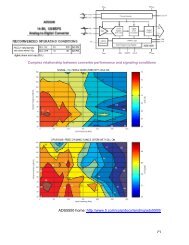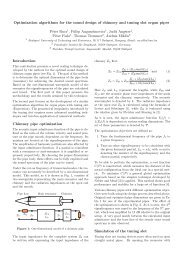HP 33120A User's Guide
HP 33120A User's Guide
HP 33120A User's Guide
Create successful ePaper yourself
Turn your PDF publications into a flip-book with our unique Google optimized e-Paper software.
Chapter 7 Tutorial<br />
Modulation<br />
In amplitude modulation, the amplitude of the carrier varies between<br />
zero and twice its normal value for 100% modulation. The percent<br />
modulation depth is the ratio of the peak information signal amplitude<br />
to the constant. When amplitude modulation is selected, the<br />
<strong>HP</strong> <strong>33120A</strong> automatically reduces its peak-to-peak amplitude by<br />
one-half so that a 100% modulation depth signal can be output.<br />
Amplitude settings are defined to set the 100% peak-to-peak amplitude<br />
independent of the modulation depth setting. Vrms and dBm amplitude<br />
settings are not accurate in AM since signals are very complex.<br />
Frequency Modulation (FM) Frequency Modulation is a process of<br />
producing a wave whose frequency varies as a function of the<br />
instantaneous amplitude of the modulating information signal.<br />
The extent of carrier frequency change is called deviation. The<br />
frequency deviations are caused by the amplitude changes of the<br />
modulating information signal. You can set the amount of the peak<br />
frequency in FM with the deviation parameter.<br />
In frequency modulation, “100% modulation” has a different meaning<br />
than in AM. Modulation of 100% in FM indicates a variation of the<br />
carrier by the amount of the full permissible deviation. Since the<br />
modulating signal only varies frequency, the amplitude of the signal<br />
remains constant regardless of the modulation. The function generator<br />
uses the deviation parameter to describe the peak frequency change<br />
above or below the carrier in response to a corresponding amplitude<br />
peak of the modulating signal. For FM signals, the bandwidth of the<br />
modulated signal can be approximated by:<br />
BW ≈ 2 x (Deviation + Information Signal Bandwidth)<br />
BW ≈ 2 x (Information Signal Bandwidth)<br />
For wideband FM<br />
For narrowband FM<br />
Narrowband FM occurs when the ratio of the deviation frequency to the<br />
information signal bandwidth is approximately 0.01 or less. Wideband<br />
commercial FM radio stations in the United States use a 75 kHz peak<br />
deviation (150 kHz peak-to-peak) and audio signals band-limited to<br />
15 kHz to achieve 200 kHz channel-to-channel spacing from the<br />
180 kHz bandwidth.<br />
288
















